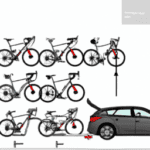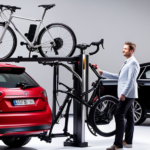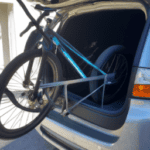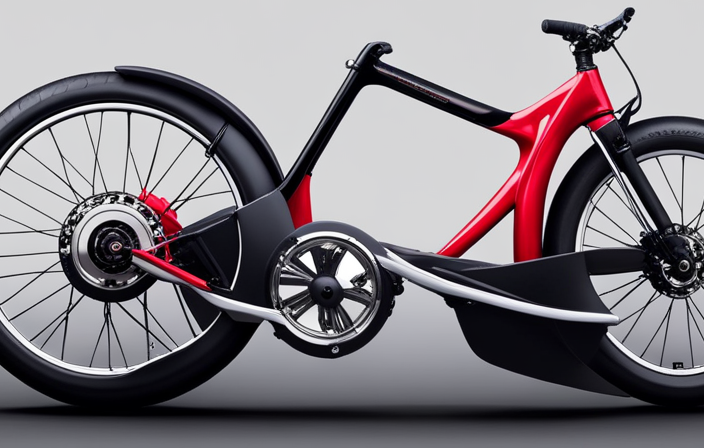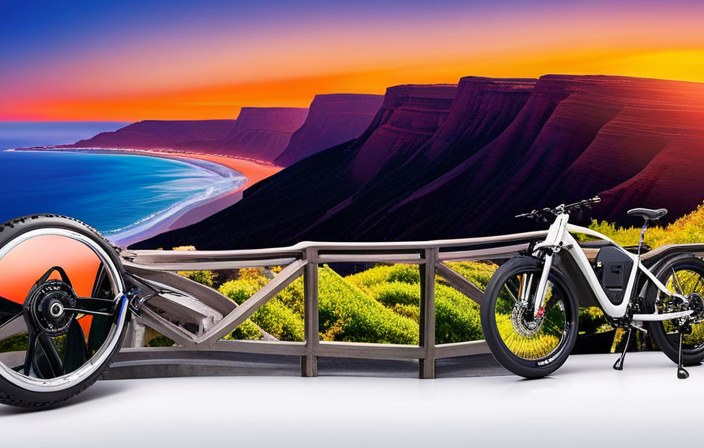You’ve got an electric bike now, huh? That’s amazing! The next thing to do is to figure out how to transport it.
Don’t worry, I’ve got all the know-how you need to make sure your precious ride stays safe and secure during transport. From choosing the right bike rack to following local regulations, I’ll guide you through every step of the process.
So buckle up and get ready to hit the road with your electric bike in tow!
Key Takeaways
- Choosing the right rack or hitch mount is essential for safely and securely hauling an electric bike.
- It is important to ensure proper installation and loading of the bike onto the rack or hitch mount.
- Look for racks specifically designed for electric bikes to ensure compatibility and proper weight capacity.
- Properly securing the bike during transportation is crucial to prevent shifting or falling.
Consider the Weight and Size of Your Electric Bike
When hauling your electric bike, you’ll want to consider the weight and size of it to ensure you can transport it safely. It’s important to choose a vehicle that can handle the weight of your electric bike, as well as provide enough space for it.
Consider the cost and maintenance of your electric bike as well, as these factors will impact your decision on how to transport it. You don’t want to invest in a vehicle or rack that exceeds the cost of your bike or requires expensive maintenance.
Additionally, you’ll want to choose a vehicle that is compatible with your electric bike, whether it’s a car, SUV, or truck. It’s crucial to make sure your electric bike fits securely and doesn’t cause any damage during transportation.
Transitioning into the next section, using a bike rack or hitch mount is a great option for safely hauling your electric bike.
Use a Bike Rack or Hitch Mount
To transport your e-bike, you can use a bike rack or hitch mount.
When it comes to bike rack options, there are several alternatives to choose from. One popular choice is the trunk-mounted bike rack, which is affordable and easy to install.
Another option is the roof-mounted bike rack, which allows you to carry your e-bike securely on top of your vehicle.
However, my personal favorite is the hitch mount. It offers a sturdy and stable platform for your electric bike, ensuring a smooth and secure ride.
With the hitch mount, you can easily load and unload your e-bike without any hassle. It’s a reliable and convenient choice for transporting your electric bike.
Choose a Rack that is Compatible with Electric Bikes
Make sure you select a rack that works with your e-bike to ensure a secure and hassle-free transportation experience. There are various electric bike rack options available, each with its own set of benefits.
Here are four key factors to consider when choosing a rack for your electric bike:
-
Compatibility: Look for a rack specifically designed to accommodate electric bikes, as they often have heavier frames and different dimensions compared to traditional bikes.
-
Weight capacity: Check the weight capacity of the rack to ensure it can handle the weight of your e-bike without any issues.
-
Ease of use: Opt for a rack that is easy to install and remove, allowing you to quickly load and unload your electric bike.
-
Security features: Look for racks that offer additional security measures such as locking systems or adjustable straps to keep your e-bike safe during transportation.
By selecting a rack that meets these criteria, you can enjoy the benefits of using a bike rack for electric bikes, such as convenience, protection against scratches or damages, and the ability to transport your e-bike without any worries.
Once you have chosen the right rack, the next step is to secure your electric bike with straps or bungee cords.
Secure Your Electric Bike with Straps or Bungee Cords
Using straps or bungee cords is a simple and effective way to ensure your e-bike stays securely in place during transportation. It’s crucial to prioritize bike storage and bike transportation to protect your investment and prevent any damage. Straps and bungee cords are versatile and can be easily adjusted to fit different bike frames and sizes. They provide a reliable hold, keeping your e-bike stable and preventing it from shifting or falling during transit. To illustrate the benefits of using straps or bungee cords, here is a visual representation:
| Benefits of Using Straps or Bungee Cords | Description |
|---|---|
| Secure Hold | Straps and bungee cords offer a tight grip, keeping your e-bike in place. |
| Adjustable | Easily adjust the tension to fit your bike’s frame and size. |
| Versatile | Compatible with different types of bike racks and transportation methods. |
Use a Tailgate Pad or Truck Bed Extender
If you’re looking for an alternative method, consider using a tailgate pad or truck bed extender to transport your e-bike. These options have their own unique benefits that can make hauling your electric bike much easier and more secure.
A tailgate pad is a padded cover that fits over your truck’s tailgate, providing a soft surface for your bike to rest on. It also usually includes straps or buckles to help keep your bike in place during transport.
On the other hand, a truck bed extender is a metal or aluminum frame that attaches to your truck’s hitch receiver. It extends the length of your truck bed, allowing you to safely transport longer items like your e-bike without worrying about it hanging off the edge.
With these options, you can transport your e-bike with confidence and ease. And when it comes to added safety, don’t forget to remove the battery before loading your bike onto the tailgate pad or truck bed extender. This will prevent any potential accidents or damage to the battery during transport.
Remove the Battery for Added Safety
Now that you have learned about using a tailgate pad or truck bed extender to safely haul your electric bike, let’s discuss another important step in the process: removing the battery for added safety.
As an electric bike enthusiast, I understand the importance of battery maintenance and charging options. Here are four reasons why removing the battery is crucial:
-
Safety: By removing the battery, you eliminate the risk of it getting damaged during transportation, which could lead to safety hazards.
-
Weight Distribution: Without the battery, the bike becomes lighter, making it easier to load and unload onto your vehicle.
-
Battery Life: Constant exposure to vibrations while driving can negatively impact the battery’s lifespan. Removing it prevents unnecessary wear and tear.
-
Charging Flexibility: By removing the battery, you have the freedom to charge it separately, allowing you to conveniently choose the best charging option available.
As we move into the next section, let’s explore how you can use protective coverings to prevent scratches and damage to your electric bike.
Use Protective Coverings to Prevent Scratches and Damage
Let’s explore how protective coverings can help prevent scratches and damage to your e-bike.
When it comes to hauling your precious electric bike, it’s important to ensure that it remains in pristine condition. Protective coverings act as a shield, safeguarding your bike from potential scratches and dings during transportation. These coverings come in various forms, such as bike wraps, bike bags, or bike covers. They are specifically designed to fit your e-bike’s dimensions, providing a snug and secure fit.
Not only do they protect the surface of your bike, but they also offer added protection against elements like dust, dirt, and moisture. Investing in quality protective coverings is a small price to pay for the long-term preservation of your e-bike.
Now, let’s move on to the next section, where we’ll discuss how to distribute the weight evenly on the rack or truck bed.
Distribute the Weight evenly on the Rack or Truck Bed
Ensure that you evenly distribute the weight on the rack or truck bed to maintain balance and prevent any potential damage.
When it comes to hauling your electric bike, whether on a truck or a bike rack, proper weight distribution is key. You want to ensure that the weight is evenly spread out to avoid any strain on the rack or truck bed. This will not only protect your bike from any potential damage but also maintain stability during transportation.
To achieve this, position the bike centrally on the rack or truck bed, making sure that it is securely fastened. Use straps or bungee cords to secure the bike, ensuring that it is tightly held in place. By evenly distributing the weight, you can enjoy a smooth and secure ride without worrying about any mishaps.
Now, let’s move on to the next important step – checking and double-checking the security of your electric bike.
Check and Double-check the Security of Your Electric Bike
To make sure your electric bike is secure, double-check all the straps and cords used to fasten it to the rack or truck bed. Ensuring the proper security of your electric bike during transportation is crucial to prevent any accidents or damage. Here are some bike transport tips for securing electric bikes:
- Inspect all straps and cords for any signs of wear or damage, replacing them if necessary.
- Tighten all straps and cords securely, making sure there is no slack or looseness.
- Use additional security measures such as bungee cords or tie-down straps for extra stability.
- Place the bike in a position where it is centered and balanced on the rack or truck bed.
- Use padding or protective covers to prevent any scratches or dings to your electric bike.
By following these bike transport tips and ensuring the proper security of your electric bike, you can have peace of mind knowing that your precious bike is safe during transportation.
Now, let’s move on to how to drive safely and securely with your electric bike.
Drive Safely and Securely with Your Electric Bike
Make sure you drive carefully and securely with your e-bike to avoid any potential accidents or damage. Proper maintenance is crucial for the longevity and performance of your electric bike. Here are some bike maintenance tips to keep in mind:
| Maintenance Tips | Benefits of Electric Bikes |
|---|---|
| Regularly check tire pressure | Environmentally friendly |
| Keep the chain lubricated | Cost-effective transportation |
| Inspect brakes for wear | Health benefits |
| Clean and protect the frame | Avoid traffic congestion |
Consider Using a Bike Trailer for Long-distance Hauling
Consider using a trailer for long-distance journeys, as it can provide additional storage space and make transporting items easier. When it comes to hauling your electric bike, a bike trailer offers numerous benefits that alternative methods may not provide.
One of the main advantages of using a bike trailer is the added storage space it offers. With a trailer, you can easily transport your bike along with other items such as camping gear or luggage. This makes it ideal for long-distance trips where you need to carry all your essentials.
Additionally, a bike trailer provides a stable and secure way of transporting your electric bike, minimizing the risk of damage or accidents. By attaching the trailer securely to your vehicle, you can have peace of mind knowing that your bike is safe throughout the journey.
However, if you prefer to avoid the hassle of hauling your electric bike yourself, you can always opt to use a professional bike shipping or transport service. This allows you to have your bike shipped directly to your desired location, saving you time and effort.
Use a Professional Bike Shipping or Transport Service
If you’re looking to avoid the hassle of transporting your bicycle yourself, you can always opt for a professional bike shipping or transport service. These services specialize in safely and securely transporting your bike from one location to another, whether it’s for a race, a vacation, or a move.
Here are four reasons why using a professional bike transport service is a great choice:
-
Convenience: With a professional service, you don’t have to worry about packing and unpacking your bike. They will take care of everything, from disassembling and packaging your bike to delivering it to your desired location.
-
Expertise: Professional bike transport services have years of experience and knowledge in handling and transporting bikes. They know the best practices to ensure your bike arrives in perfect condition.
-
Peace of mind: When you entrust your bike to a professional service, you can relax knowing that your precious bike is in safe hands. They have insurance coverage in case of any damages during transit.
-
Time-saving: Transporting your bike yourself can be time-consuming and stressful. With a professional service, you can save valuable time and focus on other important aspects of your trip or event.
Follow Local Laws and Regulations for Transporting Bikes
To ensure a safe and legal journey, remember to abide by local laws and regulations when transporting your bicycle.
When it comes to hauling an electric bike, there are a few important considerations to keep in mind.
First and foremost, familiarize yourself with the specific laws in your area regarding the transportation of electric bikes. Some places may require you to use special bike racks or have certain safety measures in place.
Additionally, be aware of any weight restrictions or size limitations that may apply. It’s crucial to follow these legalities to avoid any fines or penalties.
Now, let’s move on to the next section and discuss how to inspect your electric bike for damage after transport.
Inspect Your Electric Bike for Damage After Transport
After transporting your electric bike, it’s important to inspect it for any damage. As an avid electric bike enthusiast, I understand the significance of taking good care of your bike to ensure optimal performance.
One of the first things I do is inspect the battery condition. I carefully examine the battery for any signs of leakage or damage. Additionally, I check for loose connections to ensure that the battery is securely attached to the bike. This step is crucial because a damaged battery or loose connections can lead to poor performance or even accidents.
By thoroughly inspecting these elements, you can ensure that your electric bike is in top shape and ready for your next adventurous ride.
But inspecting your bike is just the first step in maintaining its performance. It’s important to regularly maintain and service your electric bike for optimal performance.
Regularly Maintain and Service Your Electric Bike for Optimal Performance
Regularly maintaining and servicing your e-bike is essential for keeping it in optimal condition and ensuring peak performance. As an electric bike enthusiast, I can’t stress enough the importance of proper maintenance to get the most out of your bike.
Here are four key steps to optimize the performance of your electric bike:
-
Clean and lubricate: Regularly clean your bike to remove dirt and debris that can affect its performance. Lubricate the chain and moving parts to reduce friction and improve efficiency.
-
Check tire pressure: Maintaining the correct tire pressure is crucial for a smooth ride and better traction. Inspect the tires regularly and inflate them to the recommended pressure.
-
Inspect the brakes: Test the brakes regularly to ensure they are functioning properly. Adjust and replace brake pads as needed for optimal stopping power.
-
Battery care: Follow the manufacturer’s guidelines for charging and storing the battery. Avoid extreme temperatures and fully charge the battery before each ride.
Frequently Asked Questions
Can I use a regular bike rack or hitch mount for my electric bike?
Yes, you can use a regular bike rack or a hitch mount for your electric bike. Most electric bikes are compatible with these options, allowing you to securely transport your bike wherever you go.
How do I secure my electric bike using straps or bungee cords?
I secure my electric bike using sturdy straps and bungee cords, ensuring it stays firmly in place during transportation. It’s like wrapping a protective cocoon around my precious bike, keeping it safe and secure on the journey.
What is the purpose of removing the battery when hauling an electric bike?
When hauling an electric bike, it is essential to remove the battery for safety reasons. This ensures the battery is not damaged or disconnected during transport, preventing any potential hazards and allowing for a smooth and worry-free journey.
How can I prevent scratches and damage to my electric bike during transport?
To prevent scratches and protect the frame of your electric bike during transport, you can use padded bike bags or blankets to wrap it securely. Additionally, using a bike rack or securing it inside a vehicle can help minimize any potential damage.
Are there any specific local laws or regulations I should be aware of when transporting my electric bike?
When it comes to transporting your electric bike, it’s essential to be aware of local laws regarding electric bikes. In addition, follow safety tips such as securing the bike properly, using protective covers, and obeying traffic regulations.
Conclusion
In conclusion, after exploring various methods of hauling an electric bike, it is important to consider the weight and size of your bike before choosing a suitable rack or hitch mount.
Make sure to select a rack that is specifically designed for electric bikes to ensure a secure transportation. Use straps or bungee cords to further secure your bike, and consider using a tailgate pad or truck bed extender for added protection.
If needed, professional bike shipping or transport services are available. Always follow local laws and regulations and inspect your bike for any damages after transport.
Lastly, regular maintenance and servicing of your electric bike will guarantee optimal performance. So, whether you’re heading out on a thrilling adventure or simply commuting to work, rest assured that you can transport your electric bike safely and securely.


